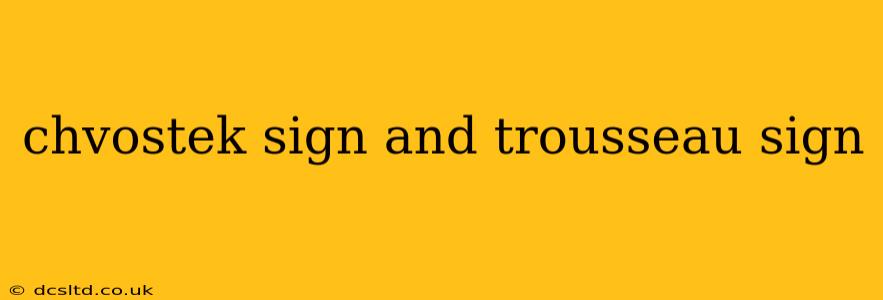The Chvostek sign and Trousseau sign are two clinical tests used to assess for hypocalcemia, a condition characterized by low levels of calcium in the blood. While both signs indicate potential calcium deficiency, they assess different aspects of neuromuscular excitability. Understanding their differences and implications is crucial for accurate diagnosis and treatment.
What is the Chvostek Sign?
The Chvostek sign is a clinical test that assesses the excitability of the facial nerve. It's performed by tapping the facial nerve in front of the ear, just below the zygomatic arch (cheekbone). A positive Chvostek sign is indicated by a brief contraction of the facial muscles on the same side of the face, typically manifesting as twitching of the mouth, nose, or eye. This involuntary muscle contraction occurs because the low calcium levels make the nerves more susceptible to stimulation.
How is the Chvostek Sign Performed?
The procedure is straightforward:
- The examiner lightly taps the facial nerve just anterior to the earlobe.
- A positive response involves a brief, visible contraction of the ipsilateral facial muscles. This can manifest as a twitch in the corner of the mouth, nose, or eye.
- The intensity of the twitch can vary, ranging from a subtle flicker to a more pronounced contraction.
What Does a Positive Chvostek Sign Indicate?
A positive Chvostek sign strongly suggests hypocalcemia, but it's not diagnostic on its own. Other conditions, such as tetany, can also produce a positive result. It's essential to consider the clinical picture as a whole and order further investigations to confirm the diagnosis.
What is the Trousseau Sign?
The Trousseau sign is another clinical test for hypocalcemia. Unlike the Chvostek sign, which assesses facial nerve excitability, the Trousseau sign evaluates the response of the hand and forearm to ischemia (reduced blood flow). It's performed by inflating a blood pressure cuff around the arm to a pressure above the systolic blood pressure for a period of 3-5 minutes.
How is the Trousseau Sign Performed?
The procedure involves:
- Inflating a blood pressure cuff around the upper arm to a pressure exceeding the patient's systolic blood pressure.
- Maintaining this pressure for 3-5 minutes.
- Observing the patient's hand and forearm for any changes.
What Does a Positive Trousseau Sign Indicate?
A positive Trousseau sign is characterized by carpopedal spasm—a contraction of the hand and fingers, often described as a "flexion of the wrist and metacarpophalangeal joints, with extension of the interphalangeal joints." This spasm is caused by the increased neuromuscular irritability associated with hypocalcemia. Similar to the Chvostek sign, a positive Trousseau sign strongly suggests but does not definitively diagnose hypocalcemia.
Chvostek Sign vs. Trousseau Sign: Key Differences
| Feature | Chvostek Sign | Trousseau Sign |
|---|---|---|
| Nerve Tested | Facial nerve | Not directly a nerve test; assesses response to ischemia |
| Stimulus | Direct nerve tapping | Inflation of a blood pressure cuff |
| Response | Facial muscle twitching | Carpopedal spasm (hand and finger contraction) |
| Sensitivity | Considered less sensitive than Trousseau sign | Considered more sensitive than Chvostek sign |
What Causes Hypocalcemia? (People Also Ask)
Hypocalcemia can result from various factors, including:
- Parathyroid gland dysfunction: The parathyroid glands play a critical role in regulating calcium levels. Problems with these glands can lead to insufficient calcium release into the bloodstream.
- Vitamin D deficiency: Vitamin D is essential for calcium absorption in the gut. Insufficient vitamin D can impair calcium uptake, resulting in low blood calcium levels.
- Chronic kidney disease: The kidneys play a vital role in calcium regulation. Kidney diseases can interfere with calcium metabolism, leading to hypocalcemia.
- Pancreatitis: Severe pancreatitis can deplete calcium levels.
- Certain medications: Some medications, like certain diuretics and some anticonvulsants, can interfere with calcium absorption or excretion.
What are the Symptoms of Hypocalcemia? (People Also Ask)
Symptoms of hypocalcemia can vary depending on the severity of the calcium deficiency. They can include:
- Muscle cramps and spasms (tetany)
- Numbness and tingling in the extremities
- Seizures
- Changes in mental status
- Cardiac arrhythmias
- Hypotension (low blood pressure)
How is Hypocalcemia Treated? (People Also Ask)
Treatment for hypocalcemia usually focuses on addressing the underlying cause and restoring normal calcium levels. This may involve:
- Calcium supplements: Oral or intravenous calcium supplements may be administered to raise blood calcium levels.
- Vitamin D supplements: If the hypocalcemia is due to vitamin D deficiency, supplementation is crucial.
- Treatment of underlying conditions: Addressing underlying conditions such as parathyroid gland disorders or kidney disease is essential for long-term management.
Conclusion
The Chvostek and Trousseau signs are valuable clinical tools for detecting potential hypocalcemia. While not definitive diagnostic tests, their presence should prompt further investigation to identify the underlying cause and initiate appropriate treatment. Understanding these signs and their implications is crucial for healthcare professionals in the diagnosis and management of calcium-related disorders. Remember to always consult a healthcare professional for proper diagnosis and treatment of any medical condition.
